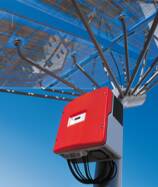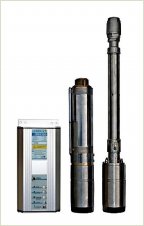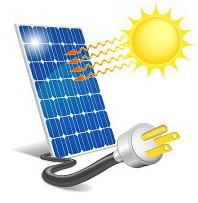How solar photovoltaic electrification works?
How solar photovoltaic electrification works?
CC
How much energy does a Photovoltaic module produce?
How does photovoltaic solar electrification work?
How much energy can a PV solar panel produce?
There are different sizes of solar panels with different peak powers: industrially there are 45 W (watts) panels of 50 or 55 W and 100 or 110 W.
Power is defined as the multiplication of the voltage "U" (in V or volts) by the current "I" (in A or amps). The result is "P" in W or Watts. In solar energy, the term "peak" is used, indicating that this function is not necessarily constant.
The energy produced "E" (in Wh or watt hours) is the power of the panel multiplied by the production time. The production time in this case is the time that there is strong solar radiation. This means sun without shadow, without clouds and with a radiation angle towards the panel between 90 and 30 degrees.
So, no more than six hours of generation per day can be calculated. In practice, it is calculated with the average number of hours of sunshine depending on the location of the solar system.
In most places in Ecuador an average of 3 to 3.5 hours of sunshine per day can be applied. This average is applied for reasons that there are days with little radiation, for example days with clouds or rain.
Power output of a 55W panel
A 55 W panel can produce with an average 3.5 hours of sunshine per day:
55 W * 3.5 h sun/d = 192.5 Wh/d ........... P (W) * Time (h) = E (Wh)
If we connect the panel with a regulator to a battery, it will charge the battery. Connecting at night, for example, a fluorescent lamp (energy saving), it would give us light for how many hours:
192.5 Wh/d generated / 20 W lamp = 9.6 hours.............. E (Wh) / P (W) = Time (h)
Hours of use with 20W 12V fluorescent lamps with a 55W solar panel
1 lamp
9,6 hours
2 lamps
4,8 hours
3 lamps
3,2 hours
4 lamps
2,4 hours
Number of lamps on:
Hours of use:
From the above calculation, it can be deduced that a photovoltaic panel with double the power (or double the size) generates double the amount of energy, and therefore will also give us double the use: 1 110 W panel with a 20 W fluorescent It would give us almost 20 light hours.
In case you want to see more calculations or want to know what size or cost a solar system has for your needs, see also "Calculations for solar energy".
Frequently asked questions about solar panels:
- Are the panels damaged by the rain?
They are not damaged by rain, they are well sealed with silicone and glass or special plastic.
- Can the panels be damaged by knocks or falls?
If they are damaged by strong blows or falls, because they have a glass on top. But they are fixedly installed on the ceiling or on a pole and thus are protected.
- Do the panels work with rain or full moon?
With rain they work, although they only produce very little energy. With the full moon they cannot generate energy because the moon only reflects the light of the sun, this light is cold and does not have enough energy.
- Should I disconnect the battery every night?
No, the entire system is connected all the time, thus taking advantage of the first rays of the sun in the morning.
- What maintenance do the panels need?
None, but it is worth going up from time to time to clean the panel of dust.
-Can I buy more panels in the future and increase the total capacity?
Yes, when the panels have the same characteristics and internal protection diodes. The battery bank can also be increased.
Frequently asked questions about the photovoltaic system:
- Is it worth connecting a water pump to the system?
If feasible, as long as the set of equipment switched on does not exceed the power of the inverter or APS. For this reason, it is more feasible to pump the water during the day and when there is strong sun.
- Why can't an iron be connected?
Because the iron consumes a lot of energy (800-1000W) this is 40 to 50 times more energy than the 20 watt fluorescent lamp.
- Why is it not profitable to install a photovoltaic system in the city?
For reasons, that public lighting costs relatively little. An amortization of the investment is calculated in 4 to 10 years, calculating the cost of public light in relation to the cost of photovoltaic light. This is not very profitable.
- If I live far away, more than 2 kilometers from public light, is it feasible to install a solar system?
Mainly yes, because for a public connection you have to pay for the technical study, the report, the poles, the transformer, the meter, the cables, labor and you have to wait your turn. If you are in doubt, ask the electricity company for a global estimate to get an idea of the costs for a public connection.
- Why do the panels have such a long useful life?
They have no moving parts and are fairly robust in construction. Its surface is mainly glass.
Solar electric systemsindependent and GRID injection (electrical network). Backup and protection of medical and computer equipment, radio communication, electric fences, cogeneration together with electro-thermal generators, air conditioning, etc.
Photovoltaic water pump systems that do not require batteries so the return on investment is very fast. These systems work fully automatic.




